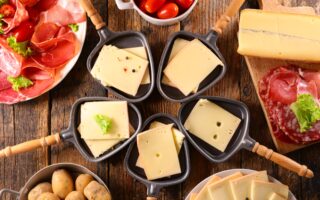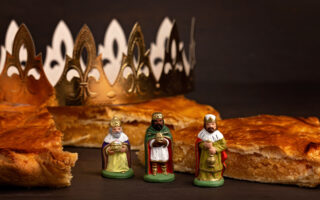Foie Gras Production
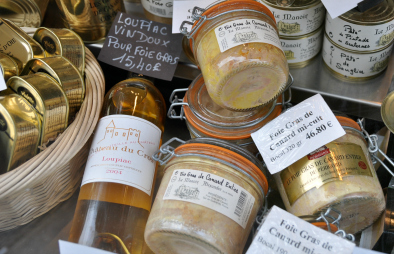
I meet and discuss farming methods with a P
Foie gras (‘fatty liver’) came to be farmed millennia ago, when people discovered that ducks and geese that had gorged themselves on maize and other crops, ready for the autumn migration, had large, fatty and nutritious livers. Nowadays, around 20,000 tonnes of foie gras are produced worldwide, each year. The French contribute 70% of that, and make up 85% of global consumption – The average French person eats foie gras at least ten times every year.
The production of foie gras is a contentious issue in the UK. Those that guiltily indulge in it have heard that it is evil, and make an effort not to find out why in case it ruins their appetite. Others have heard it is evil, so avoid the product, and reproach those who eat it. I guiltily indulged, and wanted to know why I was made to feel bad, and what all this “force-feeding” I’d heard of was all about. Having seen the free-range foie gras geese and ducks enjoying themselves on local farms, I suspected that the Brits, in our ignorance, may have got things out of proportion.

Ducks doing their thang
I spent several days with Isabelle Viresolvit, on her duck farm in rural Périgord – one of the regions, which claims to be THE foie gras-producing region of France. I watched Isabelle work and we discussed her methods for producing foie gras. She started her business, on the family farm, 18 years ago, at the age of 22, after learning her craft from her two grandmothers, and going to agricultural college. It is not a comfortable life, and all mornings start at 5am. Unless it is Sunday, when Isabelle likes to go hunting. Then she gets up at 4:30 in order to get everything done! By 8pm, all the jobs are done, and the evening meal is being prepared for her husband and two daughters.
The ducks, on the other hand, are totally free-range for most of their 4-month lives. For the last 15 days, they are brought into the stone barn for their ‘gavage’, which is the process of fattening the creatures up, and includes the infamous force-feeding. Before the gavage, Isabelle’s ducks are fed on cereals and various greens (she grows the greens herself), with no chemical, hormonal or steroidal supplements, apart from the odd worming tablet, and vitamins to give them a boost if there is a sudden change in weather. After being brought into the barn, their diet changes to maize, which Isabelle soaks and then boils to swell and soften the grains.
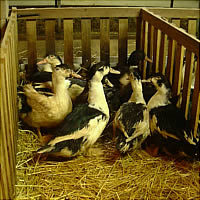
Fattened ducks in the barn
The life of these ducks is clearly very different from those in a factory farm, who are fattened as soon as they are big enough, and their carcasses are sold onto the foie gras and meat-producing factories. Isabelle explained that you will often see signs for foie gras and preserves, made ‘à la ferme’, but that these farms often buy in the ducks, alive or dead. She is relatively unusual in seeing the whole process through herself, from day-old ducklings to selling her goods. Although she has huge demand from customers all over France and Europe, Isabelle would rather turn down orders than expand her business and change its intimate dynamics. Her produce benefits from the fact that she has put so much work into caring for her ducks, and therefore treats their meat and offal with respect and care, wanting it to become the finest produce possible.
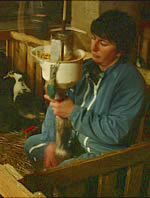
Isabelle, force-feeding.
Now we come to the force-feeding. The ducks, which are now living in straw-lined pens, are individually fed, twice a day. A motorised funnel jiggles maize down a pipe, which is carefully and expertly inserted down the duck’s throat. Isabelle holds the duck’s beak with one hand, and gently rubs it’s tummy with the other. This takes around 5 seconds for each bird. Isabelle feels that she knows and understands her ducks, and is certain that the pipe doesn’t cause the birds any pain; she would feel them wince, for a start. Although undoubtedly uncomfortable, the machine doesn’t actually ram the grain down the duck’s throat, which would seem far more brutal. The birds are not enormously fat, either. They can happily walk about, with every comfort (space, companionship, water, clean straw), until the day they die (electrocution).

Caged birds
Conveniently for me, Isabelle’s husband, Jean-Luc, does the ‘gavage’ for half the birds, and uses an industrial, battery-style method, which Isabelle disagrees with. (Unusually for a French farmer, she sometimes questions the whole concept of eating animals – usually on slaughter day!). But she needs her husband’s help, and he refuses to spend the extra time on using her traditional method (he is also paid to look after a veal herd, and has pigs, sheep, chickens…). This battery practice is due to become illegal in 2010, but for now this is how most foie gras is produced. I’m pretty certain that any bought from a supermarket would be. Anyway, I was able to see this style of farming, where the ducks are each in a tiny cage, and kept there for the whole 2 weeks of gavage. Rather a heart-wrenching sight! They hurt their wings, trying to move, but at least these poor birds had a mainly stress-free life, whereas their wretched factory cousins will not have had the luxury of a free-range upbringing.
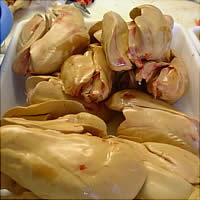
Fresh foie gras
Once the gavage and slaughter are over, every edible bit of Isabelle’s birds are used: The liver, of course, for the various forms of foie gras; the breasts (‘magrets’) are sold fresh, dried or dried around foie gras, which is super-delicious; the giblets (‘geziers’) are confited (cooked and preserved in the duck’s fat); the legs and wings are confitied, them some of then go into tins of cassoulet, which also contain home-made duck and pork sausages; the necks are stuffed with pork meat and foie gras, and are considered a delicacy in their own right; the carcasses are sold for soup and stock; the scraps are made into ‘rillettes’. It takes a maximum of 3 hours between slaughter and the production of Isabelle’s ‘foie gras entier’. Only the head, feat and remaining guts are discarded. All the goodies are either sent by post to far-away customers, or sold from the farm shop and the local market (Thenon).
So, there you have it. You might decide, after reading this, not to buy foie gras or only to buy it from a source that you know treated their birds well. You may, on the other hand, feel happy to carry on supporting the cheaper factory produce. In any case, it is worth remembering that if you ever buy any supermarket meat, or products containing meat, that don’t specify ‘organic’ (‘biologique’, in French) or ‘free-range’ (‘élevée en plein air/ en liberté’), then you will be eating factory-farmed meat. The animals who provided that meat will have led a far crueller life than Isabelle’s foie gras ducks.
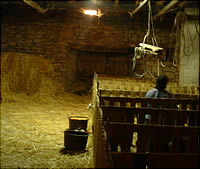
© Gemma Driver 2004
Isabelle & Jean-Luc Viresolvit
La Ferme des Marchandoux, Ajat
24210 Thenon
Lead photo credit : foie gras
Share to: Facebook Twitter LinkedIn Email
More in businesses, cooking, courses, family, learning, people, work
By Gemma Driver
Leave a reply
Your email address will not be published. Required fields are marked *

